West Berkshire
Saturday 13th November 2010
Beenham St Mary 6 9-2-23 in Ab
Speen St Mary 6 12-2-12 in G
Shaw St Mary 6 7-0-12 in A
Hugh Deam, Roy Jones, Paul Lucas, Charles Smith, Jonathan Farrington, Judith Kirby and Bernard Masterman.
Beenham Noted as Benham in the 12th century, the village name denotes an area where beans were grown. Although only a mile or so from the busy A4, the village is surrounded by woodland and gives the impression of being isolated. The present church stands on the site of two previous ones that were both destroyed by fire, the Saxon original having been struck by lightning. Only the brick tower survives from the second building, with the interior of the church noted for its wall paintings of 1876 - 82 that depict biblical scenes in a narrative sequence. The bells date to 1859 and incorporate the remains of the original bells that were wrecked by the second fire. Rung from the ground floor the bells are a treat to ring.
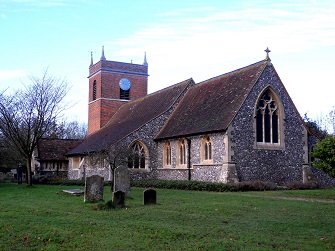
St Mary · Beenham
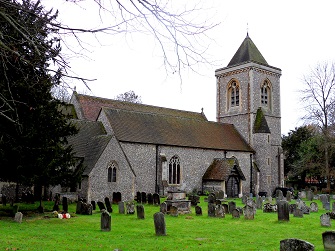
St Mary · Speen
Noted as Spene as far back as 821, then Spone by 1086, the name describes a place where wood-chips are likely to be found, an OE adaptation of the 4th century Latin name Spinis referring to thorn bushes. The church is constructed largely of flint with stone dressings having been rebuilt in 1860 by Thomas Hellyer with a new nave and chancel and the original ones converted into the north aisle and chapel. The brick tower was replaced in 1871 by G.E. Street and is capped by a pyramid roof. The bells and ringing chamber have been renovated recently and their sound is excellent.
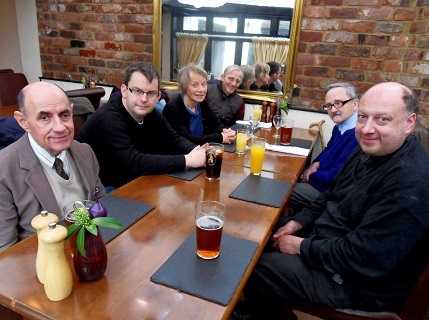
The Bunk Inn · Curridge
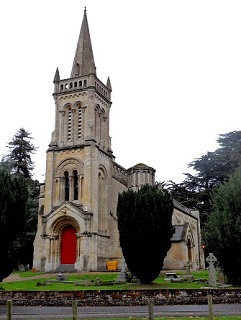
St Mary · Shaw
Taking its name from the Anglo-Saxon for a small wood or copse the first documentation was as Essages in 1086, then Shage in 1167. The sprawling village is primarily a giant housing estate on the northern fringe of Newbury that dwarfs the size of the original Shaw. The mansion of Shaw House (1579 - 81) is the largest Elizabethan house in the county. The Victorian-rebuilt church is situated on Love Lane at the rear of Vodafone HQ, with the fluent bells being rung from the ground floor.
The Bunk Inn, Curridge This charming and welcoming pub offered excellent fare, good service and relaxing surrounds. Originally known as the New Inn, the present name derives from the proclivity of farm workers and labourers once bunking off from work here.
West Sussex
Saturday 23rd October 2010
Fernhurst St Margaret 3 4-2-6 in C
Easebourne St Mary 8 11-0-21 in G
Lodsworth St Peter 6 6-2-12 in C
Tillington All Hallows 5 6-1-10 in C
Northchapel St Michael & All Angels 6 3-0-7 in E
Heather Banyard, Hugh Deam, Susan King, Margaret Marsh, Janice Beale, Steve Everett, Judy Kirby, Donna Murphy, Jonathan Beale, Roy Jones, Paul Lucas, Charles Smith, Christian Burrell, Paul Kimber, Claire Malone-Lee, Richard Bennett and Martin Dibble.
For me it could not have been a better excursion. Having returned only last week from Australia and now finding myself plunged into the heart of "Englishness" in a bellringer minibus en route to the West Sussex Downs to ring at five parish churches of medieval origin. The day was full of pale sunlight sparkling off the wet green meadows and casting long shadows from its low position above the horizon and the driving by Richard efficient and fast. There are about 400 parish churches in Sussex begun after the Norman Conquest and still retaining medieval features of thick stone walls, small windows and beautiful wood framed roofs and a tower and spire (originally to have advantage over the Danes). These churches were added to, enlarged and upgraded in both Tudor times and Victorian and now the pride of small communities who maintain them and their extensive graveyards in lush green grasses. They embody the historical and social changes of England over 1300 years from pagan times to now. Our first stop was in Fernhurst at the church of St Margaret of Antioch of the early crusades dragon slaying fame. The ladies of the community were there with tea, coffee and biscuits. An organist played for us while others were arranging flowers. In this church hangs a large millennium tapestry made by the children of the parish. We rang in the tiny 3 bell tower only 8 feet square, with a very narrow steep circular stair and a shingle covered spire. The rain came and alternated with bursts of sunshine before our next stop at St Mary's Easebourne, a nice ring of 8 bells. This old church before the Reformation had a priory for six nuns built in 1273. Then onto St Michael's Lodsworth with a good ring of 6. Here was notable for a more elaborate millennium tapestry, accomplished and beautiful, which told the story of 100 years of parish life. Our fourth stop All Hallows Tillington 5 bells has a Scottish Crown spire is famous for being painted by both Turner and Constable and for retaining much Romanesque sculpture. Finally St Michael's Northchapel where the original ring of three bells is now augmented to a six. These were good but very light. Add to this a comfortable lunch in the historic Horse Guards Inn and at the end of the day a drive back through the beautiful landscape with a setting sun glowing through the last of the clouds. Margaret Marsh
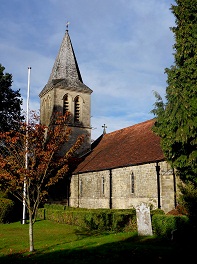
Fernhurst
Fernhurst Situated on the western Weald, which is now part of the newly created (2009) South Downs National Park, the ninth park to be so designated in England, the village sits on the southern slopes of Blackdown, the largest hill in the county. Being so close to the border with Surrey it is unsurprising that the village displays notable aspects of both counties. The original C12th church was rebuilt in the 19th century and borders a large triangular green. The work was one of the last carried out by one of the great architects of the age, Anthony Salvin who lived in the village. Despite only possessing three bells they are rung regularly and so they trip round easily. Tea and biscuits were made available for us on our arrival and our thanks are due to the tower.
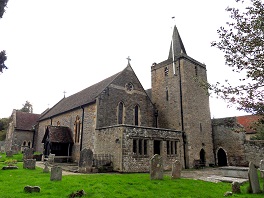
St Mary · Easebourne
An archetypal "estate village" on the far side of the River Rother from the market town of Midhurst. Many of the houses here are painted a deep yellow colour known as "Cowdray Yellow" denoting the Liberal leanings of the 2nd Viscount Cowdray. The interior of the Tudor castle was destroyed by fire in 1793, but later became a popular Victorian tourist attraction, especially with artists. The grounds were landscaped by Capability Brown, with the church standing adjacent to the entrance to the world famous Polo Grounds.
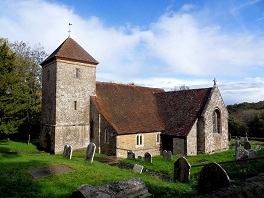
St Peter · Lodsworth
Several elaborate Cowdray family monuments transferred from Midhurst are to be found within the church which was originally constructed as a priory church for Augustinian canonesses in 1238, but which later fell into disrepair and was subject to a restoration by Blomfield in 1876. The bells are rung from the ground floor in a ringing room somewhat similar to that at Brightwell cum Sotwell in South Oxfordshire.
Lodsworth The village sits amidst the Rother Valley that runs from north to south, and is overlooked by Blackdown and Gallows Hill, with the River Lod running parallel on the eastern fringe. A spring here known as St Peter's Well became a place of pilgrimage
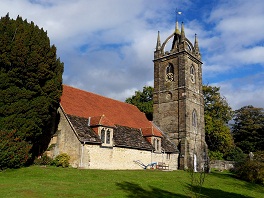
All Hallows · Tillington
during the Middle Ages due to accounts of the blind regaining their sight after drinking the water. The church is set slightly away from the village and is an exquisite building with a tower dating to the 14th century, with the three oldest bells founded in 1602, 1606, and 1648. These excellent bells were rehung in 1988 and are rung from the ground floor.
Tillington Set on a limestone ridge the village is situated within a Conservation Area, and with roughly one third of the mainly timber-framed houses being Grade II Listed it boasts the highest percentage of such in the entire country, and consequently it is popular with tourists. The Horseguard's Inn stands directly across the road from the church and gained its unique name from the cavalry who often stopped
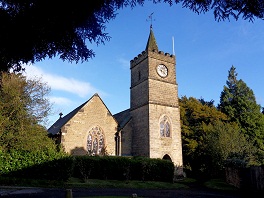
St Michael · Northchapel
here overnight as they escorted gold bullion from London to be handed over to the Navy in Portsmouth. The core of the church is medieval, but the tower, which was restored in 1992, is pretty much unique in England due to its Scots tower which was constructed as an "eye-catcher" for the many influential artistic visitors here at the time, such as famed landscape painter Turner.
Northchapel Located at the highest point in the county and close to the border with Surrey the village is set on the clay soil of the Low Weald and developed thanks to the Saxons timber-working and summer grazing. Rather like Easebourne the village developed under the patronage of the local great estate, in this case Petworth, and especially during the time of the 3rd Earl of Egremont who amassed a vast collection of paintings and sculptures. The church is tucked away behind a small grouping of houses on the east side of the village. All the bells, bar the 3 which is the original bell here, have their names displayed on the wall beside the corresponding rope, Matthew, Mark, Luke, John and Stillard. Contrary to what their light weight may suggest these are a splendid set of bells thanks to some expert counter-balancing, and are positively worth ringing.
Northamptonshire
Saturday 16th October 2010
Nether Heyford St Peter & St Paul 6 7-3-7 in G#
Pattishall Holy Cross 6 11-2-24 in G
Weedon Lois SMV & St Peter 6 6-2-21 in A
Hugh Deam, Andrew Dunn, Simon Edwards, Roy Jones, Judy Kirby, Maarit Kivilo, Paul Lucas and Charles Smith.
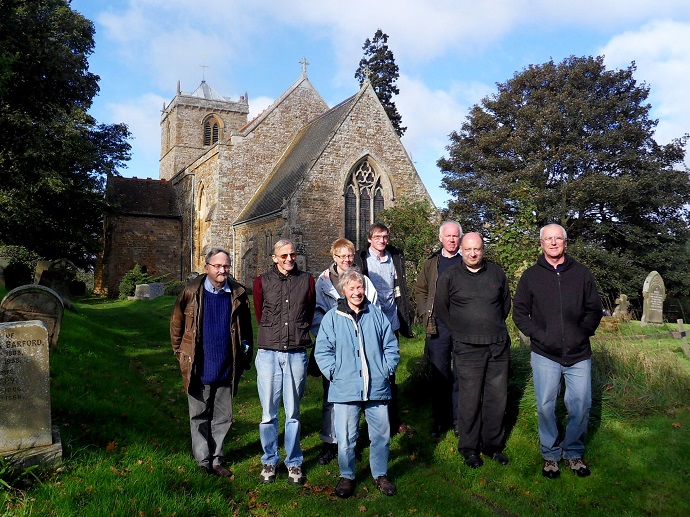
SMV · Dodford
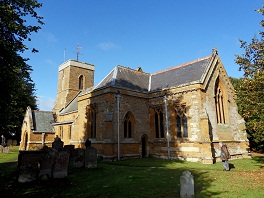
Nether Heyford
Dodford The village sits astride the valley which has been formed by an east-flowing tributary of the River Nene. The parish church was rebuilt under orders of Ralph de Keynes in 1100, with the tower and north chapel added by William de Keynes in 1221. The bells, five of which date to the 17th century, hang in a timber frame placed diagonally in the tower. They were unringable for many years until frame strengthening work in 2007.
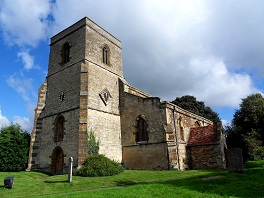
Holy Cross · Pattishall
The ford here that was used at hay-making time gives its name to the village, with the affix Nether differentiating the village from the Oxfordshire one of the same name. Apparently, despite this many outsiders used to mistakenly wind up here whilst searching for the US Air Force base. The village is set adjacent to the Grand Union Canal with the church tucked away on the eastern edge. The bells are a very fluent six rung from the ground floor.
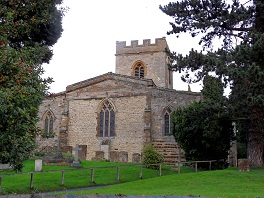
SMV & St Peter · Weedon Lois
Originally called Pascelle, the current name derives from the Pattishall family who were law-makers and judges here from the late 12th century. The village comes within the uniquely named Fosters Booth parish. The elegant church is set on high ground with the excellent sounding bells a treat to ring.
Weedon Lois Originally called Wedone (a heathen temple) the distinguishing affix derives from 1475 (Leyes Weedon) and the village well that was named after St Loys and was long a place of pilgrimage due to stories of the water having miraculous properties. The church occupies the centre of the village, with herringbone masonry within the west wall and a crossing tower combining to evidence the Norman cruciform church that preceded the current late C14th building. Ascending up to the ringing chamber is somewhat akin to climbing up to an attic, with the room dominated by a sturdy hanging wooden beam that crosses the room and makes seeing between ropes 6 to 3 and 4 & 5 rather awkward.
Adventures aboard The Venturer
Saturday 14th August 2010
Nick & Ginny Boyes, Donna Murphy, Richard Bennett, Margaret Marsh, Steve & Annika Everett, John Pusey, Janice Knowles & Christopher, Jon Beale, David Ingrouille, Paul Lucas & Heather Banyard.
From Aristotle Lane, up the canal through Wolvercote, turning left into Duke's Cut & onto the river Thames or Isis. Then through King's Lock, along to Godstow Lock by the Trout pub, through Port Meadow under Osney Bridge, through Osney Lock, past Christ Church Meadow, under Donnington Bridge and then along to the Isis Pub in Iffley. Here we turned round, back through Osney Lock then turning right into the Sheepwash Cut, onto the canal, then back to Aristotle Lane. Paul Lucas
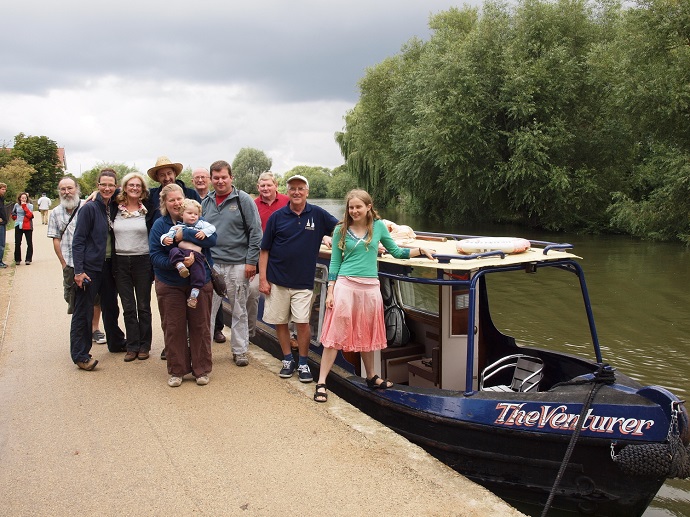
The Venturer
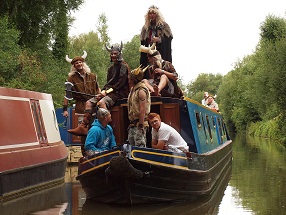
Local Vikings
Margaret Marsh writes On a damp and wet Saturday morning, bellringers from several Oxford church towers embarked on a narrowboat adventure from Aristotle Lane in Jericho. We were fourteen in all, including our skipper John, lock operator Paul and baby Christopher. There were many photographers and would be entertainers. So in pleasurable company we began our journey on the khaki green water of the narrow Oxford Canal. Ahead of us was the archaeology of the journey: it was to be a day of seeing the canals, cuts, locks, bridges and tow paths. And of glimpses into an English lifestyle of canal leisure activities. Some of these are voyaging and sightseeing as we were, or boating holidays, "dress-up as Vikings" trips, pub crawls by boat,
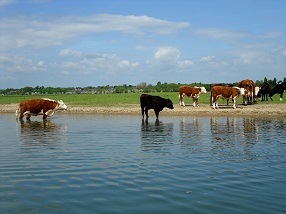
Port Meadow
fishing as well as painting and photographic pursuits. The locks were interesting, from the small manual ones on the canals to the automated larger locks on the Thames. We imagined the more nostalgic experience of bygone days when the horses pulled the boats into the locks. The tow paths, where horses once lived out their lives traversing England, are now the playfields of walkers, cyclists, dogs, children and even the Rector of St Giles in Oxford. At Godstow we saw him, hailed him and soon he was aboard our narrowboat for his first ever ride and joining in with our relaxing conversations. Commenced in 1769 and finished in 1790, the Oxford Canal is 77 miles long and part of the
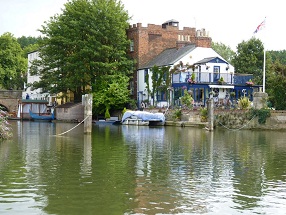
Approaching Folly Bridge
2000 mile network managed by British Waterways. The Oxford Canal was a link to London from the industrial heartland of the Midlands. It is a part of the legacy from an industrial past before the railways and the automobile. Despite these inventions, the traffic flow of goods continued until the 1950s - a long epoch of the social history of transport of goods and lives lived on the boats. Our visual experiences were very diverse - from the very narrow intimate canals, where the blackberries were within reach and almost ready to be picked, to the wider cuts and the open waterways and onto the Thames and through the city of Oxford. The moored narrowboats were interesting, occupied now as dwellings and domesticated in a
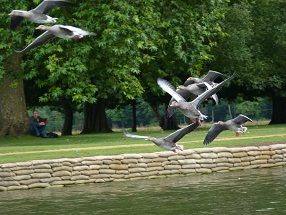
Geese at Christ Church Meadow
variety of ways - flowers in pots, vegetables cultivated in bags and even on one boat two statues of headless dogs, and a bird cage without birds. We saw glimpses of the gardens backing onto the canals and the raggedy disorder of the allotments where tall trellises of Indian runner beans, ripe cornstalks and tomatoes were thriving. We travelled down the Oxford Canal engaging with the locks, passing other narrowboat traffic. We passed through the Duke's Cut lock. The Duke of Marlborough had this cut dug from his estate to the Oxford Canal to facilitate delivery of his coal. We saw the site of The Old Paper Mill at Wolvercote on the Mill Stream tributary of the Thames closed only five years back perhaps. And heard stories of how artists and writers
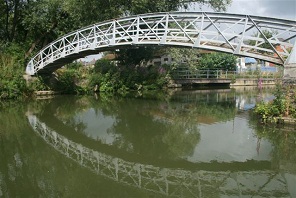
Almost home ...
would travel to the mill by boat to collect their paper supplies. We passed the ruins of the nunnery founded 13th century at Godstow; abandoned at the Reformation. Skipper John, who told stories of life on the canal, was full of knowledge and he told of the changing practices of canal life - for example how the barge owners used to dredge the silt and sell it to the farmers until increased traffic halted this due to the high level of metals in the silt from exhausts from the fuel barges.
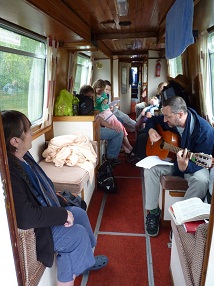
... but let's just wait
Now British Waterways has the task of dredging and safe disposal of the silt. He also told us of the eroding of the verges by too fast cruising by some boats. The verges are stabilized by the planting of bulrushes embedded in matting. After some time we reached Port Meadow and could look across at the spires on the skyline of Oxford. Then we glided under many bridges at Jericho, Osney and Grandpont. We stopped at the Isis pub in Iffley, which was the far extent of our travels, and at this point a dramatic thunderstorm hit with a sub tropical downpour. So some of us indulged in ale at the Isis and then we reboarded the Venturer for the return journey. This alternated between rain and sunshine, which glinted on the water reflecting the diverse patterns of trees, foliage, huts, ramps and bridges. During the return journey the entertainment was resumed by extrovert Steve on guitar with Heather, John and Ginny in full song. Cyclists and other travellers halted to listen creating a joyful mood. And more handbells too. We plan to go again on another adventure, but must wait for Spring, as the flow of the Thames is too rapid in winter for a narrowboat and the heating fogs up the windows, obscuring a view. Many thanks to Paul Lucas for organising the trip. It was a wonderful thing.
Aston Abbotts · Buckinghamshire
Saturday 7th August 2010
Aston Abbotts St James Gt 6 6-2-27 in G
Heather Banyard, Paul Kimber, Tom Luxford, Ryan Noble, Hugh Deam, Judith Kirby, Bernard Masterman, Charles Smith, Hal Drysdale, Paul Lucas and Donna Murphy.
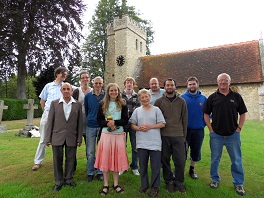
Aston Abbotts · St James Gt
The village owes its name to the ancient abbey here that served as a country residence for the abbotts of St Albans Abbey until the Dissolution when the Dormer family took posssession of the land and property in Moat Lane. The remains of the original abbey are now mostly buried beneath the 11-bay replacement that was constructed during the course of the 19th century near the church which was also rebuilt in the second half of the C19th by G.E. Street, retaining only the late Perpendicular west tower. The stained glass is some of the most interesting of early C20th work reflecting the vision of the Arts & Crafts era. Three of the bells (2,3 & 5) date back as far as 1652 being the work of Chandlers blacksmiths in Drayton Parslow, the ring of six bells being emanantly fluent. During World War II the exiled Czech president Dr Edvard Benes and his staff stayed at Abbey House and conducted military intelligence meetings (1940 - 45). After the war he donated the money for the bus shelter in the village which carries his name. Within the grounds of the Abbey is a lake which has two islands amidst it that commemmorate the other famous resident of the village, Sir James Clark Ross, the explorer who discovered the magnetic North Pole in 1831 and later spent four and a half years at sea exploring the South Pole, the Ross Sea being named after him. The islands in the lake are named Erebus and Terror, the two ships which Ross used on his South Pole expedition. Besides farming, the other notable employment within the village for many years was lacemaking and the making of straw plaited hats and bonnets. As usual for our picnic and ringing occasions the weather had been showery on the day, but by early evening when we camwe to share our provisions conditions were just about the balmiest we have had for several years.
Langford · Oxfordshire
Saturday 24th July 2010
Langford St Matthew 6 8-2-25 in A
Susan King, Judith Kirby, Roy Jones, Alison Merryweather-Clarke, Hugh Deam and Charles Smith.
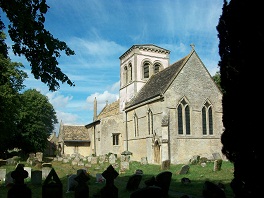
St Matthew · Langford
Langford Situated just north of Lechlade on the very western edge of the county, the name obviously derives from the Anglo Saxon for a "long ford". Given its location close to the broadening River Thames it should come as no surprise that the area is prone to flooding. Two major military skirmishes have been played out within the confines of the parish due to the strategic importance of Radcot Bridge. In December 1387 the army raised by Henry Bolingbroke (later Henry IV) defeated the forces supporting Richard II here. During the Civil War the Royalists garrisoned the bridge as an outer defence for Oxford, but during the final phase of the war a small but well-drilled Parliamentary force stormed the garrison and took 200 Royalist prisoners. There has been a place of worship in the village since late in the 10th century, with the present church dating to about 1080 by Aelfsige of Faringdon and using Saxon masons. The tunnel vault inside the tower is possibly one of only three such Saxon vaults in the country, although there is some dispute that it may have been inserted a century or so later. The south porch carries the limestone sculptures of the Crucifixion with the figures of Our Lady and St John, and the Langford Rood, a robed figure of Christ unique in England. Both are thought to have been preserved from the previous building. The back five bells were cast in 1741 at the Witney works of Henry Bagley III, although the tenor was recast in 1953. Up until early 2008 the bells had lain unrung for over a decade, but a ground-swell of local interest led to practices resuming.
Oxfordshire
Saturday 3rd July 2010
Witney St Mary V 8 16-3-11 in E
South Leigh St James Gt 8 10-1-26 in G
Christian Burrell, Simon Edwards, Judith Kirby, Paul Lucas, Phil Sampson, Hugh Deam, Roy Jones, Maarit Kivilo, Bernard Masterman and Mark Wastie.
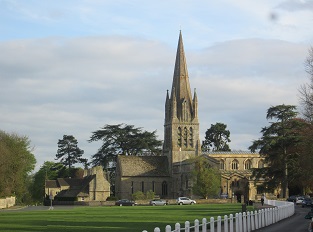
St Mary · Witney
The town of
Witney came to prominence during Saxon times, and expanded again in the years leading up to the Reformation. The Bishops of Winchester had a palace here which they used as a country residence, and the remains of which are to be found at the rear of the parish church of St Mary the Virgin. For many centuries Witney was a pivotal centre for the weaving of blanket cloth due to the waters of the Windrush containing nitrous qualities suitable for the fulling process. Church Green is surrounded by the very impressive presence of the church, the buttercross and the rows of C16th and C17th almshouses. The ring of eight bells always leaves a good impression.
South Leigh This three-pronged village runs from the River Windrush across to Tar Wood and Cogges Wood. By the early part of the 13th century the settlement was documented as Suthleye (southerly clearing of a wood). During medieval times the village actually resided within the Lincoln Diocese.
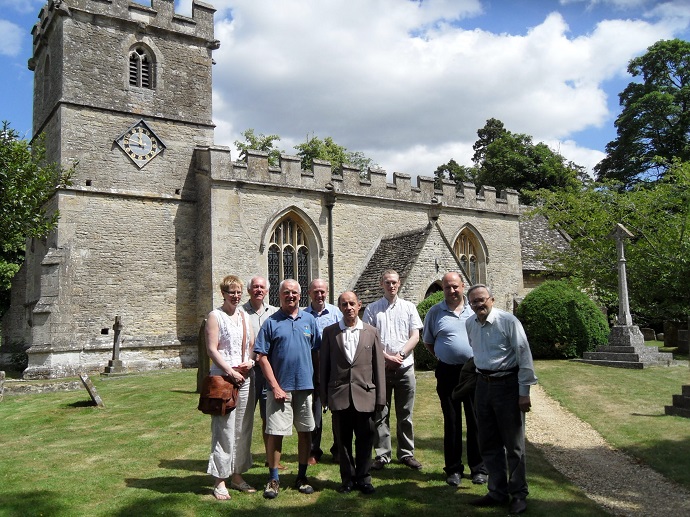
St James Gt
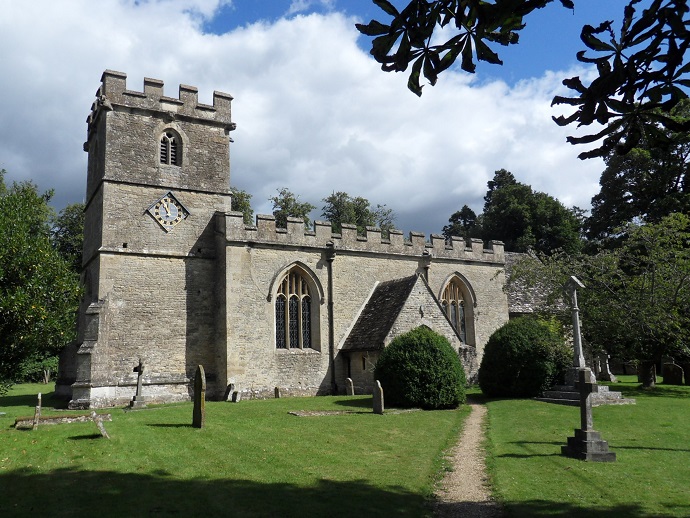
South Leigh
The church is set away from the main part of the village, and surrounded by a scattering of farmhouses and cottages. This is the first church that John Wesley is recorded as preaching in back in 1771. The chancel, north chapel, nave, north aisle and west tower are all late 15th century, whilst certain other aspects of the church possess a Romanesque style. The bells are rung from the ground floor and are ideal for extended periods of ringing.
Kennet Valley · Berkshire
Saturday 26th June 2010
Chaddleworth St Andrew 4 6cwt in B
Brightwalton All Saints 6 8-1-21 in G
Farnborough All Saints 5 8cwt in A
Compton Parva St Mary & St Nicholas 6 9-0-27 in Ab
Peasemore St Barnabas 6 8-0-11 in A
Christian Burrell, Hugh Deam, John Hearn, Maarit Kivilo, Charles Smith, Alan Coates, Andrew Dunn, Roy Jones, Paul Lucas, Kate Crosby, Simon Edwards, Judith Kirby and Bernard Masterman.
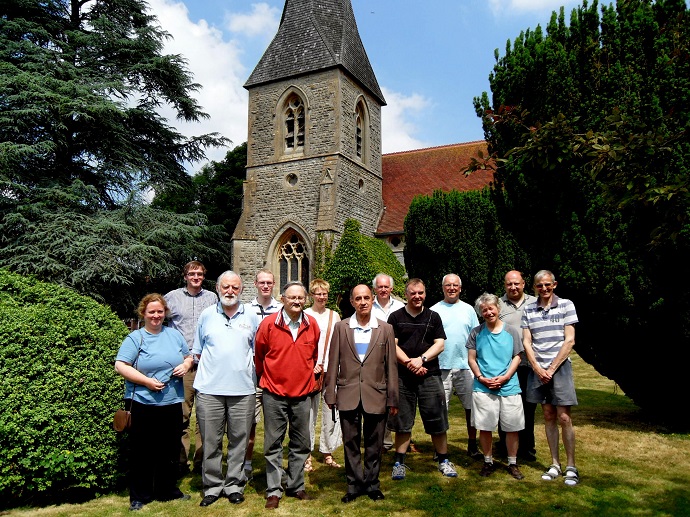
Brightwalton
Chaddleworth A small settlement was first noted as Caedelnwyrth (Ceadala's Enclosure) in 960 A.D. with no fewer than three ancient sites having been excavated locally.
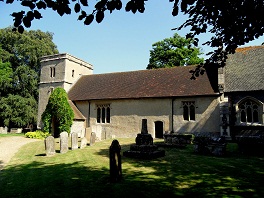
St Andrew · Chaddleworth
Although diggings were inconclusive, pottery found here pointed towards this having been an Iron Age site. During the Middle Ages the manor was held by Amesbury Priory. The village of today is still largely surrounded by woodland with the church situated west of the village. The south doorway is the only Norman remnant of the present church. The bells are rung from the ground floor and are a revelatory splendid four.
Brightwalton The earliest notation of a settlement here was as Beorhtwaldingtune (Beorthwald's Estate) in 939 A.D.
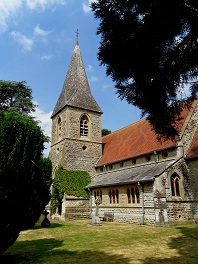
Brightwalton
The church is in the rock-faced C13th style but actually dates to 1862/3 by G.E. Street with exceptionally fine quality stained glass of that time by eminent Burne-Jones. The south-west tower is capped by a shingled broach spire. The bells are rung from the ground floor and are reassuringly fluent, although the treble is set rather fine. As at Farnborough the stained glass window of the tower is of immense interest and widespread renown.
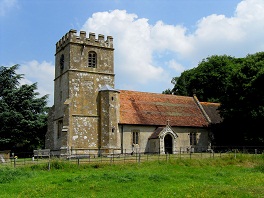
All Saints · Farnborough
Being one of several so named towns or villages in southern England, Farnborough derives its name from a hill or mound covered with ferns. The nave of the church remains from late Norman times with the late Perpendicular west tower being constructed of flint. The bells are rung from the ground floor and are due to be converted to be rung mechanically in the near future. The treble and tenor are C17th from a foundry that existed in Wokingham.
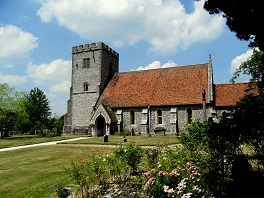
Compton
Noted in the Domesday Survey as Contone (Farmstead in a valley) the affix Parva was added to differentiate the village from several other Compton's in the south of England. The village is probably best known for the Agricultural Research Station here. Adjacent to Compton on Cow Down is the site of a 15 acre Iron Age hill-fort known as Peterborough Castle that followed a circular plan.
The church is set some distance to the east of the village, with the main body primarily from 1850, although the west tower remains essentially untouched from C13th.
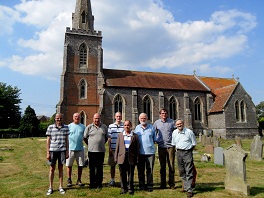
St Barnabas · Peasemore
The bells are a fluent six ideal for minor method ringing.
Peasemore The village name refers to a pond that adjoined a field of peas from the 11th century. Evidence has been found of an Iron Age settlement here around five thousand years ago, with the stone and flint tools that have been unearthed now residing in the Ashmolean Museum in Oxford. The first church in the village was founded in 1104 by Richard of Peasemore, although it was subject to a rebuilding on a rather grand scale from 1842. The bells have very recently been re-hung and re-tuned and we were privileged to be the first visiting band to experience this resurgent and resonant six.
Itchen Valley · Hampshire
Saturday 19th June 2010
Colden Common Maybells Campanile 12 0-0-11 in B
Owslebury St Andrew 6 9-0-1 in A
Twyford St Mary 8 10-3-17 in G
Compton All Saints 3 3-2-9 in D
Sparsholt St Stephen 6 7-1-20 in A
Avington St Mary 5 6-1-0 in Bb
Christian Burrell, Roy Jones, Paul Lucas, Hugh Deam, Paul Kimber, Bernard Masterman, Steve Everett, Judith Kirby and Donna Murphy.
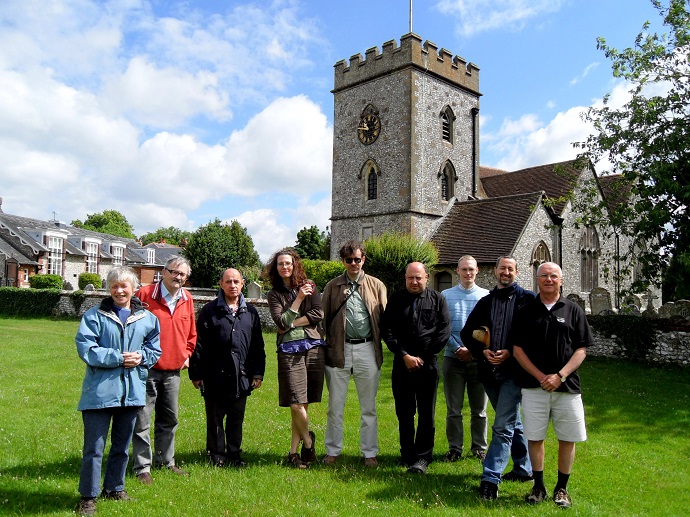
Owslebury
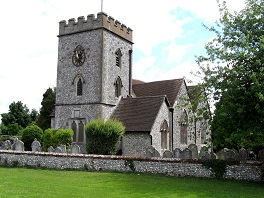
St Andrew · Owslebury
Colden Common The parish has grown out of what was originally the hamlet of Bambridge, having been granted to the then newly-established Corpus Christi, Oxford. In 1974 the village hit the national headlines when 70,000 tons of tyres stored in a disused clay pit here caught alight and required 68 fire engines to bring the conflagration under control in what was nicknamed the "tyre pyre" and took 15 days to damp down. The campanile bells are rung from within the garage of the property and help and advice is readily on hand from the owner as to what is a thoroughly different style of bell control.
Owslebury Taking its name from Osla's stronghold frequented by blackbirds,
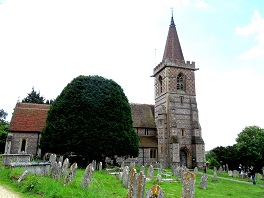
St Mary · Twyford
the settlement here came about due to its strategic position at the top of a hill, and subsequently several ancient routes such as the Pilgrim's Trail, Monarch's Way and the Roman road from Winchester all criss-crossed near here. Despite all these routes nearby the village (pronounced Osslebury) was known up until early C20th as the "unknown village" such was its isolation and lack of documentation. The majority of the church is Early English with the west tower dating to 1675. The bells are rung from the ground floor with the 5 & 6 requiring a stance on the plinth of the font.
Twyford First noted as Tuiforde
c.970 the name refers to there being a double ford here. After the coaching era drew to a close Twyford remained a popular through route to the coast with cyclists as late Victorian fashionable society embraced this new pursuit.
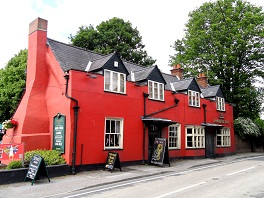
The Phoenix Inn · Twyford
On the eastern fringe of Twyford is a diligently preserved Edwardian water pumping station that extracted water from the chalk downland for over a century and which is now open to the public. The church of 1876/7 is situated on meadowland next to the river and is built of knapped flint. With the churchyard dominated by a 1000 year old yew tree that is argued to be the best maintained in southern England. The bells are a splendid eight with no foibles.
The Phoenix Inn Following our last two outings that included great pubs for lunch, the standard was more than kept up here, with all the elements of a memorable lunch, namely a warm welcome, excellent meals,
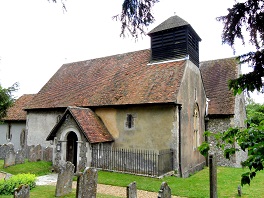
All Saints · Compton
service, prices, and a wealth of photographic memorabilia pointing up the abundance of angling and cycling activity associated with the pub since Victorian times onwards.
Compton Known locally as Compton Street, the village also incorporates Shawford and primarily consists of a long main street that follows the course of the chalk valley. The area is noted for its wealth of butterflies, attracted by the proliferation of orchids in particular. The church is highly unusual in that it has two naves and two chancels due to the original Norman examples being supplemented by new examples in 1905. The bells are rung from the ground floor in a semi-circle around the font.
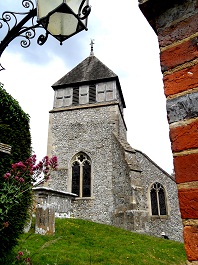
St Stephen · Sparsholt
The name of the village is a reference to the propensity of spear shafts once made here from the local forest around 901 A.D. when the settlement was documented as Speoresholte. The village is best known by regard of the agricultural college that bears its name and which features regularly on BBC Radio 4's Gardeners' Question Time. The majority of the church is Victorian restoration work from 1883 with only small reminders from C13th such as the priests' doorway and south arcade. The bells here are ideal for fluent ringing.
Avington The village is situated amidst the Upper Itchen Valley alongside the river as it meanders to Cheesefoot Head.
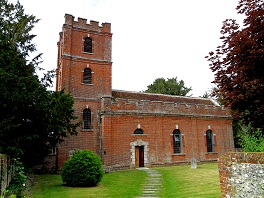
St Mary · Avington
King Edgar granted the land to Winchester Priory. In 961 A.D. King Edgar granted the land to Winchester Priory. The manor house of Avington Park was used by Charles II and his mistress Nell Gwynne when he visited Winchester. The village is one of the few in the country to have a folk song named after it, namely "Avington Pond". A distinctive row of cottages here served as barracks for some of the Duke of Wellington's crack troops during the Napoleonic Wars. The brick built church dates from 1768 - 71 on the death of the Marchioness of Caernarvon who is buried here. The interior of the church is of immense interest with inordinately high sided Spanish mahogany box pews. The bells are rung from a gallery and though fluent are extremely loud.
Aylesbury Vale
Saturday 1st May 2010
Shabbington Bucks · St Mary Magd 6 5-3-22 in B
Emmington Oxon · St Nicholas 3 6-0-7 in B
Tetsworth Oxon · St Giles 6 4-2-25 in Db
Anita Clayton, Anthony Hughes, Mary Kirklees, Donna Murphy, Hugh Deam, Roy Jones, Peter Lloyd, Charles Smith, Andrew Dunn, Judith Kirby and Paul Lucas.
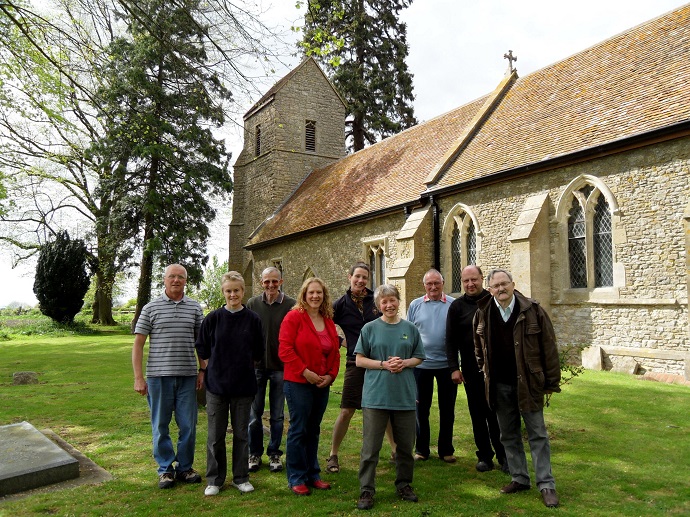
Emmington
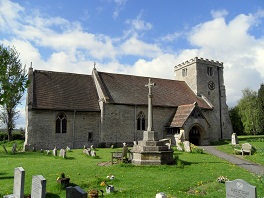
St Mary Magd · Shabbington
Shabbington This low-lying village, first documented as Slobintone (Sleobba's Estate), is situated on the northern bank of the sublimely meandering River Thame with the road on its western fringe often being impassable due to flash flooding. The spelling of the village name only changed to Shabbington during the Victorian era. The first recorded owners of the manor here were the Knights of St. John of Jerusalem. The southern edge of the village is particularly scenic, approached via two bridges and dominated by the widely known riverside pub the Old Fisherman and then a few hundred yards further on the
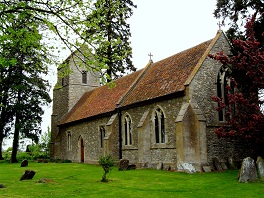
St Nicholas · Emmington
graceful C11th parish church. These excellent bells are hung anti-clockwise and though currently rung from the ground floor, late 2010 will see an upstairs ringing chamber installed.
Emmington Known as Amintone (Eama's Farm) in 1086, Emmington is more like a hamlet than a village, reached via a narrow lane, and consisting of a mere handful of cottages, a church, a large duck-pond, a modern mansion house, and a pub on the main road between Thame and Chinnor. The early C14th church was rebuilt in 1874 by Buckeridge and Pearson to the original plan, and possesses a saddleback roof to its tower.
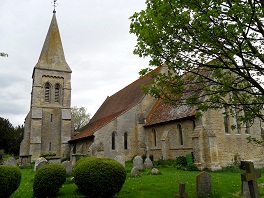
St Giles · Tetsworth
It was declared redundant in 1987, but the tower was strengthened and new fixtures added to allow the bells to be rung again, and they considerably easier to ring than most three bell sets. Access to the church and surrounding land is by prior appointment only.
Tetsworth The village is situated on the fertile plain of the Chiltern escarpment and derives its name from Taetel's enclosure, being documented as Tetleswrthe circa 1150. The main trunk road between Oxford and London long ran through Tetsworth and the broach spire of the church is easily visible from the M40. Although the village no longer has a general store it does specialise in antique shops, and is known to many outsiders for being the venue of a massive weekly Car Boot Sale during the summer months. The parish church was rebuilt in 1855 by J Billing in the Early English style as a replacement for what had once been an elaborate Norman building. The bells are a splendid light six.
Kennet Valley · Berkshire
Saturday 24th April 2010
Beedon St Nicholas 6 6¼cwt in Bb
Chieveley SMV 8 11-0-3 in F
Peasemore St Barnabas 6 8-0-11 in A
Lunch at
The Bell Aldworth
Bernard Masterman, Hugh Deam, Susan King, Margaret Marsh, Charles Smith, Andrew Dunn, Judith Kirby, David Ingrouille, Christian Burrell, Roy Jones and Paul Lucas.
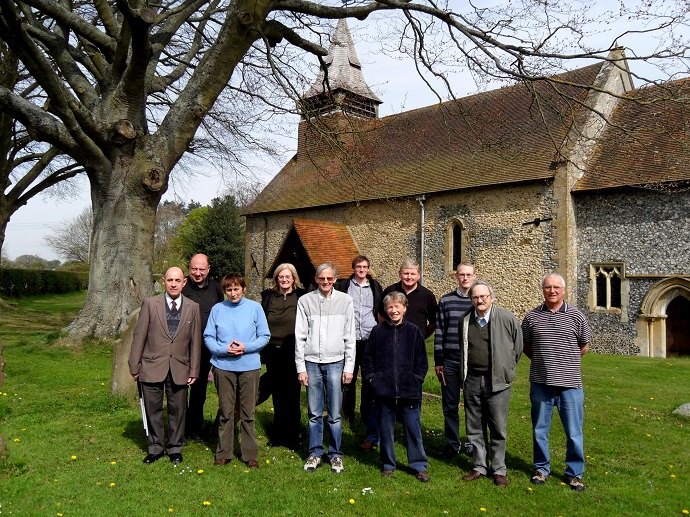
Beedon
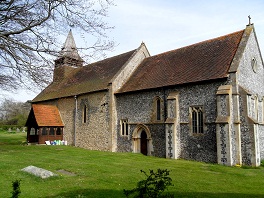
St Nicholas · Beedon
Little did we know that our outing to Berkshire would provide such contrasts. From the seldom rung bells of Beedon to the new rehanging at Peasemore we enjoyed the lows and highs of bell ringing experiences. Down a lonely road outside Beedon somewhere near World's End is an old 13th century rather charming church of knapped flint. The timber framed bell tower is situated inside and at the rear of the church. The jackdaws had been nesting in the bell chamber and there were cobwebs on the walls. Even the experienced ringers amongst the group found the bells with their long ropes and small wheels very challenging to handle. Then onto St Mary the Virgin at Chieveley with its extensive very old graveyard and squat 13th century tower and up the wooden circular stair to eight rather nice bells which proved much more enjoyable experience for the eleven Oxford ringers. Finally onto St Barnabas Peasemore where we were the first visiting band to ring since the rehanging of the bells and they were beautiful to ring. It was as if these six bells "could ring themselves". We found the church full of beautiful flowers and learnt that a prestigious wedding was to be held there later that day for David Cameron's sister was to marry there. Then onto a pub for late lunch - The Bell Inn at Aldworth - which has not been ruined by alterations for smart tourist types and was favoured by visiting bikies and old car enthusiasts. Like them we enjoyed the sunshine and beer and a good Ploughman's lunch. Margaret Marsh
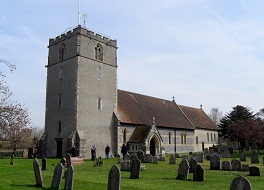
SMV · Chieveley
Beedon The village name denotes the enclosure that primarily was used for the growing of beans, and long comprised two hamlets attached to Reading which subsequently expanded around the two pubs and then eventually merged into a single village. The present church is situated away from the village on the site of its predecessors, the original Saxon church having burned down after being struck by lightning in 1794 and its replacement meeting a similar fate just a century later. The broken bell metal was collected up and used in the casting of a new set of bells, with the nearby Six Bells pub having taken its name by way of commemorating this event.
Chieveley First documented as Cifan-Lea, the village name denotes the proliferation of chives that were once grown here. Set amidst rolling chalk hills the village is chiefly known by dint of the M4 service station at Jct 13.
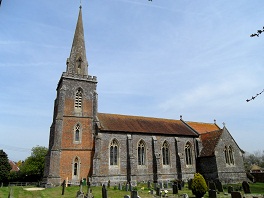
St Barnabas · Peasemore
There has been a church here since Saxon times when King Edred held the manor, although only the C15 west door, C14 chancel and C13 tower remain in the wake of a wholesale Victorian rebuilding. The original peal of six bells were tuned and hung in a new frame in anticipation of the augmentation to eight which took place in 1982.
Peasemore The village name refers to a pond that adjoined a field of peas from the 11th century. Evidence has been found of an Iron Age settlement here around five thousand years ago, with the stone and flint tools that have been unearthed now residing in the Ashmolean Museum in Oxford. The first church in the village was founded in 1104 by Richard of Peasemore, although it was subject to a rebuilding on a rather grand scale from 1842. The bells have very recently been re-hung and re-tuned and we were privileged to be the first visiting band to experience this resurgent and resonant six.
The Bell, Aldworth This C13 building has been run as a pub since the mid 18th century by the same family and is not only full of ambience, but offers an array of meals in rolls or ploughman's.
Oxfordshire
Monday 19th April 2010
7.30pm
Chalgrove St Mary 6 16-0-14 in F
Christian Burrell, Hugh Deam, Andrew Dunn, Simon Edwards, Brian Gray, Roy Jones, Judy Kirby, Maarit Kivilo, Paul Lucas and Bernard Masterman.
Cambridge, Double Court, Double Oxford, Single Oxford & Double Bob.
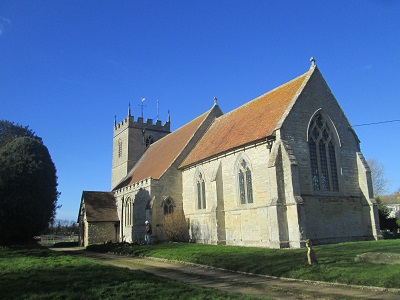
Chalgrove · St Mary
Chalgrove The Domesday Book (1086) described the settlement here at that time as Celgrave (a chalk-pit). Chalgrove Field was the battlefield where, in 1643, the Royalist forces led by Prince Rupert defeated a Parliamentarian force during the early part of the Civil War. The leading light in the Parliamentary cause, John Hampden was killed in this battle and a stone monument to him stands on what is thought to be the spot where he met his end. Royalist supremacy was short-lived as Hampden’s cousin. Oliver Cromwell reorganised the Parliamentary forces into an ultra-professional unit. In common with many of the towns and villages in this part of the Chilterns there were several coaching inns dotted across Chalgrove, with The Lamb being the most notable pub still trading, with its own cricket club & ground and clay pigeon shooting club. The parish church is tucked away on high ground behind a plethora of new housing on the south side of the village. The churchyard extension of 2009 is known as “The Labyrinth” as it was cut into the grass in the shape of a scallop shell., a shape which has been symbolic with Christian pilgrimage since medieval times. Dating from early in the 12th century, construction on the church was begun by monks from Bec, a Benedictine abbey in Normandy. The piers in the south arcade have square capitals from Norman times, with those in the north arcade being from the 13th century. The chancel is decorated on three of its walls by a near complete set of medieval wall paintings, from around 1320, which were added at the bequest of the de Barantyn family. Having been lime-washed over for many years they were rediscovered as a result of renovation work that took place on the interior of the church during 1858. Other than necessary renovation and refurbishment, the whole building is considered to remain substantially as it was in 1500. Three of the six bells (2, 3, and 4) were cast in 1664 by Henry II Knight of Reading, with the treble, originally of also of that date, recast in 1888 by Henry I Bond of Burford. The back two bells date to 1729, cast by Abraham II Rudhall of Gloucester.
Oxfordshire
Saturday 17th April 2010
Souldern SMV 6 7-3-6 in G
Roy Jones, Judith Kirby, Maarit Kivilo, Hugh Deam, Bernard Masterman and Paul Lucas.
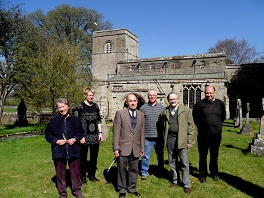
SMV · Souldern
Souldern Documented as Sulethorne around 1160, the village name denotes its inception at a thorn-tree in or near a gully. The crossroads at the heart of Souldern is graced by a large pond that adjoins the lane leading to the church and rectory that William Wordsworth stayed in whilst writing his sonnet A Parsonage in Oxfordshire. For a couple of centuries the village was a centre for lacemakers, with three specialist schools here at one point during the C19th. The church dates to the 12th century, having four bells from C17th onwards. The tower was dismantled and rebuilt 1906/07 with the bells being recast at Whitechapel and two trebles added, a further recast and rehanging taking place in 1997 that now makes these one of the most pleasingly fluent sets in the county.
West Sussex
Saturday 20th March 2010
Chichester Cathedral Holy Trinity 8 18-1-12 in Eb
Aldingbourne SMV 5 6-1-14 in B
Yapton St Mary 6 6-2-12 in Bb
Lunch at the
Fox & Hounds Funtington
Funtington St Mary 6 5-3-21 in Bb
Janice Beale, Roy Jones, Paul Lucas, Jonathan Beale, Susan King, Margaret Marsh, Christian Burrell, Judith Kirby, Bernard Masterman, Hugh Deam, Jonathan Farrington, John Pusey, David Ingrouille, Peter Lloyd and Charles Smith.
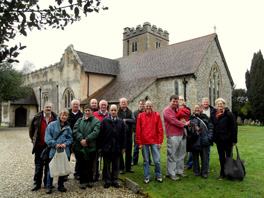
Aldingbourne
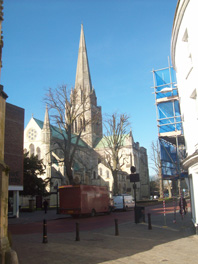
Holy Trinity
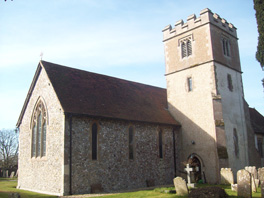
Aldingbourne
Chichester Cathedral Being one of the smallest cathedral cities it follows that Chichester is also one of the most unspoilt and picturesque, its origins dating back to 1 BC, with the remains of an even earlier hill-fort known as the trundle overlooking what was a neolithic causeway. Chichester is situated on the north-east corner of the Selsey Peninsula where the Romans and Saxons landed on their initial invasions of England, and also where St Wilfred landed on his mission to bring Christianity to the country. The original cathedral, ordered by St Wilfred when the bishopric took its name from Selsey, now lies under the sea; so much has the coastline receded inland over the years. The bells are rung from a large detached tower that is situated in the grounds of the cathedral and approached via a path overlooked by an imposing statue of Saint Richard.
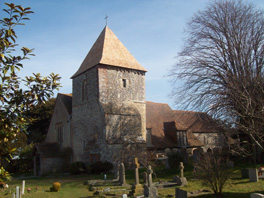
Yapton
The pretty C12th church serving the village has a classic "chocolate box" setting, unencumbered by housing save for a cottage either side of the large churchyard, this being due to the Black Death of 1359 wiping out most of the population here and subsequent rebuilding to the west. The Bishops' Palace also stood adjoining the church until 1642 when it was razed to the ground by Parliamentary forces in the Civil War. The bells are rung from the ground floor and despite only being a five they attract large numbers of ringers due to their flowing nature.
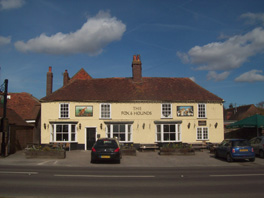
The Fox & Hounds
This now extensive village is situated on the coastal plain just north of the seaside resort of Littlehampton, with much of the expansion stemming from the construction of the Portsmouth to Arundel canal. Yapton was the centre for a massive amount of smuggling of brandy from France in times past due to its location and hinting name, being Not Pay when reversed. The C12th church is constructed primarily of flint rubble with a shingled south-west tower. A fire in the tower in 1909 left the 1870/1 restoration work on the main body of the church mostly untouched, but the four
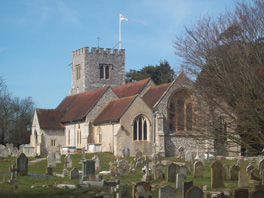
Funtington
bells were subsequently recast and the rim of the tenor converted into a candlebrum. They were augmented to a six in 1985.
The Fox & Hounds, Funtington After experiencing some considerable difficulties at several of the pubs we have booked on outings in the last couple of years, this was quite simply as good as one could ever hope for it to get. Excellent main meals and desserts, the promptest of service and welcoming atmosphere, recommendations can't come any higher.
Funtington This attractive village is bordered by the remnants of ancient yew forests. Funtington has long had strong naval links, with Funtington House having served as a centre for radar training during World War II. The parish church adjoins not only the grounds of the manor house, but also an immense pig farm which occupies much of the acreage once owned by the manor house. The yew tree in the churchyard is thought to slightly pre-date the C12th church itself. The bells are rung from the ground floor and trip round beautifully.
Northampton
Sunday 27th February 2010
All Saints Northampton 10 17-0-4 in E
Holy Sepulchre Northampton 8 14-3-7 in F#
St Peter & St Paul Abington 6 10-1-24 in A
St Benedict West Hunsbury 6 3-2-20 in D
St Edmund Hardingstone 5 12cwt in F#
Christian Burrell, Hugh Deam, Heather Dobson, Andrew Dunn, Simon Edwards, David Ingrouille, Roy Jones, Susan King, Judith Kirby, Peter Lloyd, Ryan Noble, John Pusey and Charles Smith.
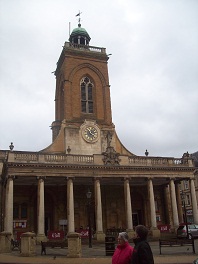
All Saints
Northampton Only remnants are now visible of the castle that once guarded the town during medieval times when Northampton served as a place of judicial administration, with Thomas Becket being the most celebrated defendant to be tried here. The growth of the British empire led to the town becoming known the world over for the manufacture of shoes, primarily footwear for military usage.
All Saints with St Katharine and St Peter Only the west tower and the crypt of the original C12th church survived the Great Fire of Northampton in 1675, with the rebuilding styled on one of Christopher Wren's designs and using 1000 tons of timber gifted by the king from the royal forests of Salcey and Rockingham. The church overlooks the market square at the heart of the town. A brand new ring of ten bells were installed in 2006 to replace the previous eight, cast by Taylors their individual names denote the ten chapels of the original church building.
Holy Sepulchre Located in Sheep Street this is the oldest building in Northampton and is one of the very few surviving Norman round churches in the country, a style directly influenced by the Holy Sepulchre in Jerusalem which the Crusaders, in this case Simon de Senlis, Earl of Northampton, sought to recreate on their return from the Holy Land. The west tower is C14th with the excellent bells rung from the ground floor.
Abington Aptly nicknamed "the church in the park", St Peter & St Paul served as the place of worship for the owners of the manor and the estate workers. William Shakespeare's grand-daughter, Elizabeth Bernard is buried here having overseen the building of the manor house and the rebuilding of the early C13th church. The park is approached from the church via an avenue of mature trees and contains a lake, bandstand and cafe. The bells here are a superb six rung from the ground floor.
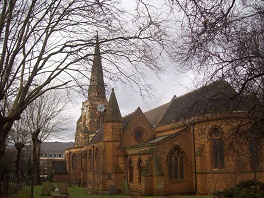
Holy Sepulchre
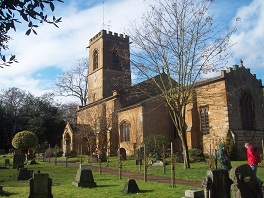
St Peter & St Paul · Abington
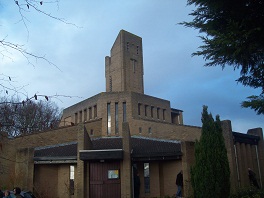
St Benedict · West Hunsbury
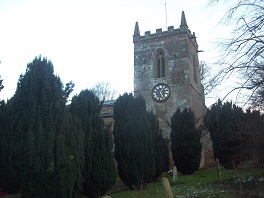
St Edmund · Hardingstone
Now an outer suburb of Northampton, Hunsbury was originally an Iron Age hill fort. East and West Hunsbury are separated by a plethora of road networks, with the extremely modernistic concrete church situated in the westerly village. The bells have only recently been augmented to a six and are rung from a similarly concreted ringing chamber.
Hardingstone The village is noted for possessing one of only three Eleanor Crosses remaining from the original twelve that were constructed to denote the route of the funeral cortege from Lincoln to London for Queen Eleanor in 1290. The C14th parish church has been much restored, with the tower dating to a century earlier. The ringing chamber has recently been moved upstairs and consequently the ceiling is rather low, with the bells being on plain bearings.


























































